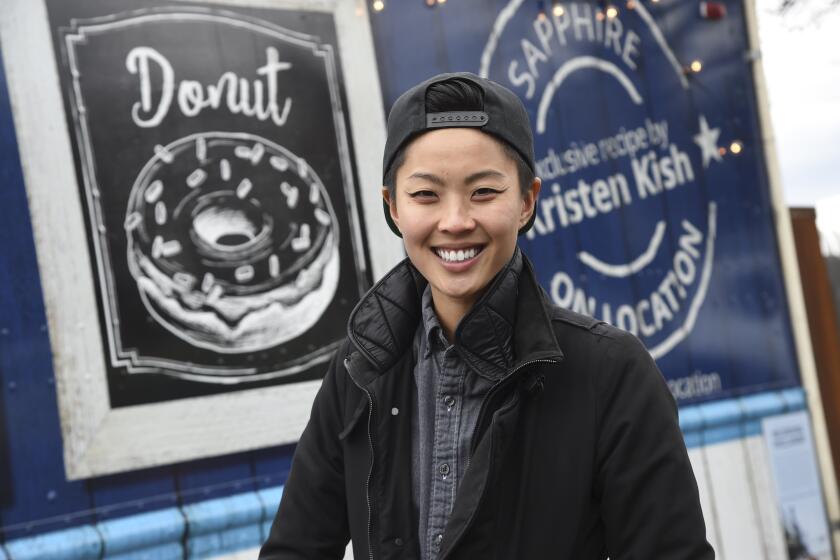Drinking a hearty glass of blush
- Share via
Milan’s Osteria L’Intrepido restaurant won Wine Spectator magazine’s award of excellence this year despite a wine list that features a 1993 Amarone Classico Gioe S. Sofia, which the magazine once likened to “paint thinner and nail varnish.”
Even worse: Osteria L’Intrepido doesn’t exist.
To the magazine’s chagrin, the restaurant is a Web-based fiction devised by wine critic and author Robin Goldstein, who said he wanted to expose the lack of any foundation for many food and wine awards.
To pull off the hoax, Goldstein created a bogus website for the restaurant and submitted an application for the award that included a copy of the restaurant’s menu (which he describes as “a fun amalgamation of somewhat bumbling nouvelle-Italian recipes”) and a high-priced “reserve wine list” well-stocked with dogs like the 1993 Amarone.
The application also included what Goldstein suggests was the key qualification: a $250 entry fee.
“I am interested in what’s behind all the ratings and reviews we read. . . . The level of scrutiny is not sufficient,” said Goldstein, who revealed the prank while presenting a paper at an American Assn. of Wine Economists meeting in Portland,Ore., last weekend.
In response, Wine Spectator Executive Editor Thomas Matthews listed in a posting on the New York-based magazine’s website its “significant efforts to verify the facts”:
“a. We called the restaurant multiple times; each time, we reached an answering machine and a message from a person purporting to be from the restaurant claiming that it was closed at the moment.
“b. Googling the restaurant turned up an actual address and located it on a map of Milan.
“c. The restaurant sent us a link to a website that listed its menu.”
Wine Spectator even found discussion about the restaurant from purported diners on the foodie website Chowhound.
In a telephone interview, Matthews denounced Goldstein’s actions as a “publicity-seeking scam.”
He also denied that the award of excellence was designed to generate revenue for the magazine. “This is a program that recognizes the efforts restaurants put into their wine lists,” he said.
Matthews said the magazine did not attempt to visit the phony Milan restaurant; it never visits about 200 of the establishments that get its award each year. But he said the awards had contributed to the growing popularity of wine since they were started by the magazine in 1981.
Getting the award, however, isn’t exactly like winning an Olympic medal. This year, nearly 4,500 restaurants spent $250 each to apply or reapply for the Wine Spectator award, and all but 319 won the award of excellence or some greater kudos, Matthews said.
That translates to more than $1 million in revenue.
Tom Pirko, a beverage industry consultant who lives in Santa Barbara County’s wine country, said the hoax would dent the magazine’s credibility.
“This gets down to what the Wine Spectator is all about. It’s not exactly Wine for Dummies; it’s more Wine for the Gullible,” Pirko said. “This gives the appearance of paying for advertising disguised as a contest.”
Restaurants that win the award receive a plaque they can mount for diners to see and a listing as a wine-friendly establishment on the magazine’s website. They typically use the award as a form of marketing and advertising, Pirko said.
Goldstein said he came up with the idea while doing research for an academic paper about the standards for wine awards. He is coauthor of “The Wine Trials,” a book that looks at how 500 blind tasters from around the country evaluated 6,000 wines ranging in price from $1.50 to $150 a bottle.
He contends that people think wine tastes better when they know it is expensive, citing as evidence taste tests that show two-thirds of people preferred a $12 Domaine Ste. Michelle Brut, a Washington state sparkling wine, to a $150 Dom Perignon Champagne.
When he crafted the bogus wine list for Osteria L’Intrepido (Italian for “The Fearless Restaurant”) Goldstein also included a 1985 Barbaresco Asij Ceretto, which Wine Spectator described as “earthy, swampy, gamy, harsh and tannic.”
“While Osteria L’Intrepido may be the first to win an award of excellence for an imaginary restaurant,” Goldstein said, “it’s unlikely that it was the first submission that didn’t accurately reflect the restaurant.”
--
More to Read
Eat your way across L.A.
Get our weekly Tasting Notes newsletter for reviews, news and more.
You may occasionally receive promotional content from the Los Angeles Times.











